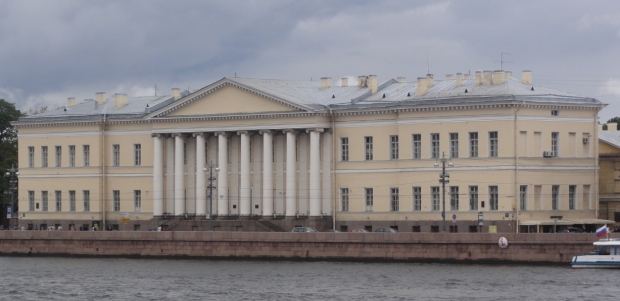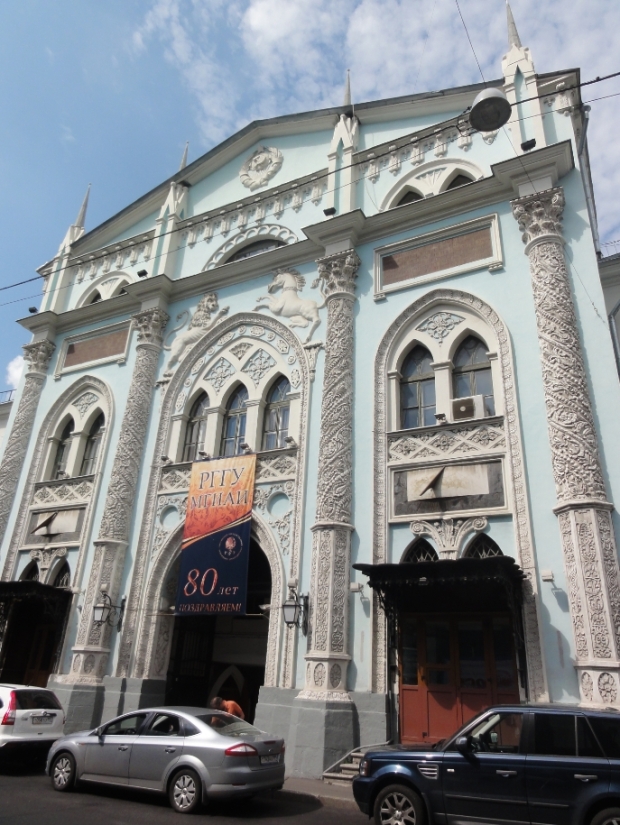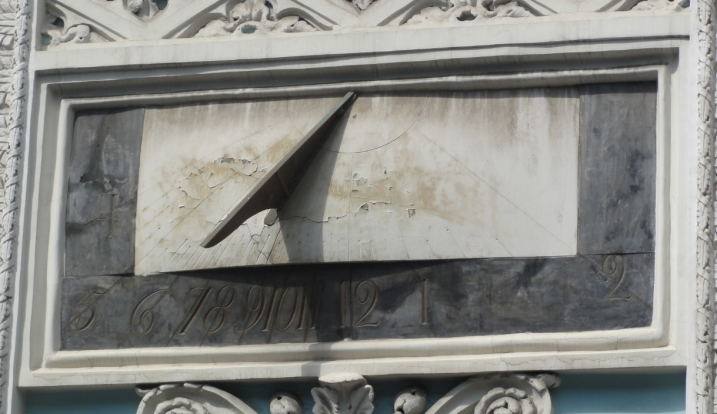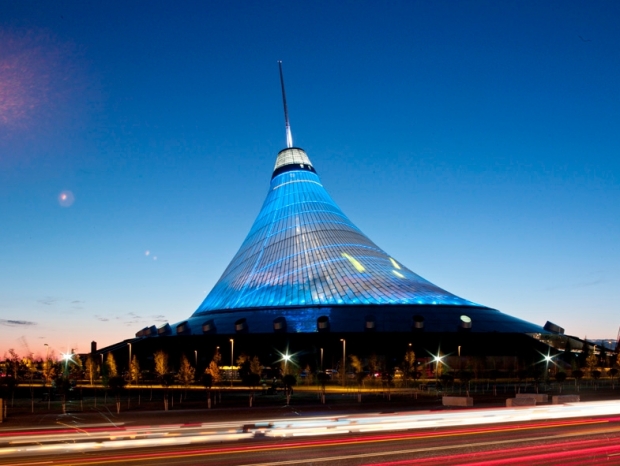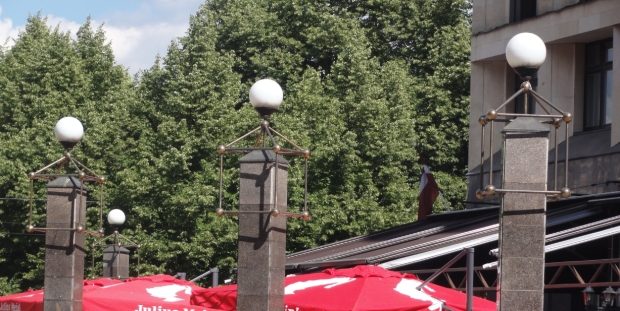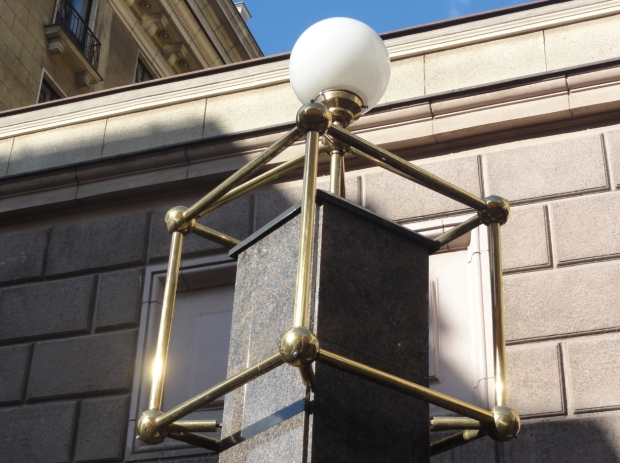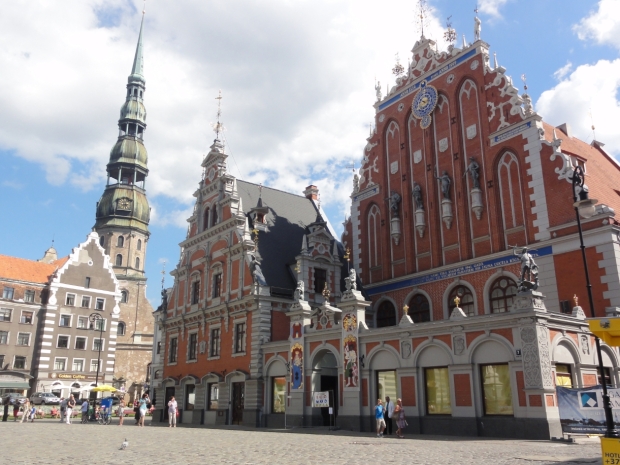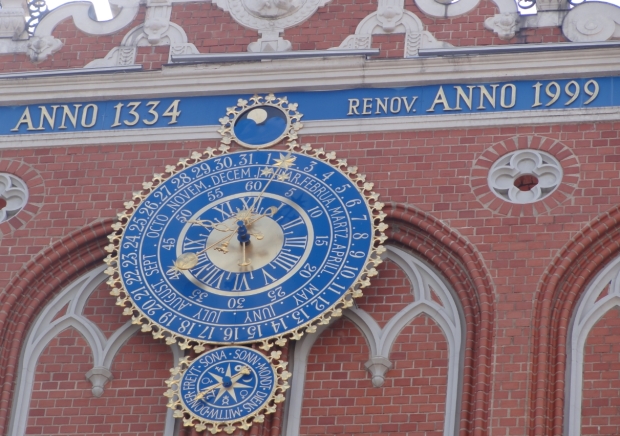Leonhard Euler’s tomb
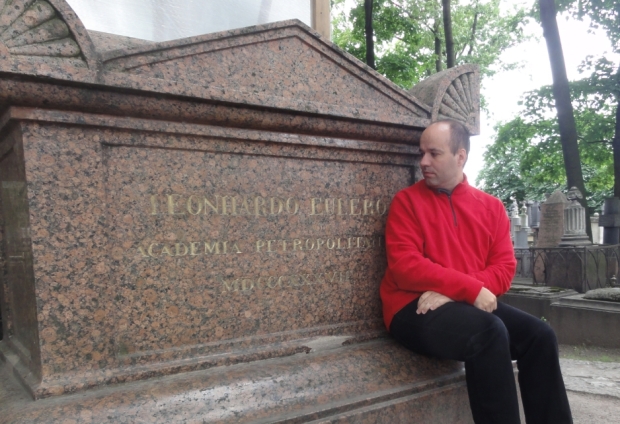
Euler and me
Today is 31 December 2012, the last day of this year. I’ve thought that the last post of 2012 must be related with my best mathematical moment of the year: I visited Euler’s tomb in Saint Petersburg in holidays! Euler was one of the best mathematician in the history of mathematics! According to D. M. Burton (The History of Mathematics, The McGraw-Hill Companies, Inc., 1991):
The key figure in eighteenth century mathematics was Leonhard Euler (1707-1783), and the scene of his activity was chiefly Germany and Russia.
A short Euler’s biography can be read in V. J. Katz (A History of Mathematics, Addison Wesley Longman, 1998):
Born in Basel, Switzerland, Euler showed his brilliance early, graduating with honors from the University of Basel when he was 15. Although his father preferred that he prepare for the ministry, Euler managed to convince Johann Bernoulli to tutor him privately in mathematics. The later soon recognized his student’s genius and persuaded Euler’s father to allow him to concentrate on mathematics. In 1726 Euler was turned down for a position at the university, partly because of his youth. A few years earlier, however, Peter the Great of Russia, on the urging of Leibniz, had decided to create the St. Petersburg Academy of Sciences as part of his efforts to modernize the Russian state. Among the earliest members of the Academy, appointed in 1725, were Nicolaus II (1695-726) and Daniel Bernoulli (1700-1782), two of Johann’s sons with whom Euler had developed a friendship. Although there was no position in mathematics available in St. Petersburg in 1726, they nevertheless recommended him for the vacancy in medicine and physiology, a position Euler immediately accepted. (He had studied these subjects during his time at Basel).
In 1733, after Nicolaus’ death and Daniel’s return to Switzerland, Euler was appointed the Academy’s chief mathematician. Late in the same year, he married Catherine Gsell with whom he subsequently had 13 children. The life of a foreign scientist was not always carefree in Russia at the time. Nevertheless, Euler was able generally to steer clear of controversies until the problems surrounding the succession to the Russian throne in 1741 convinced him to accept the invitation of Frederik II of Prussia to join the Berlin Academy of Sciences, founded by Frederik I, also on the advice of Leibniz. He soon became director of the Academy’s mathematics section, and with the publication of his texts in analysis as well as numerous mathematical articles, became recognized as the premier mathematician of Europe. In 1755 the Paris Academy of Sciences named him foreign member, partly in recognition of his winning their biennial prize competition 12 times. Ultimately, however, Frederik tired of Euler’s lack of philosophical sophistication. When the two could not agree on financial arrangements or on academic freedom, Euler returned to Russia in 1766 at the invitation of Empress Catherine the Great, whose succession to the throne marked Russia’s return to the westernizing policies of Peter the Great. With the financial security of his family now assured, Euler continued his mathematical activities even though he became almost totally blind in 1771. His prodigious memory enabled him to perform detailed calculations in his head. Thus he was able to dictate his articles and letters to his sons and others virtually until the day of his sudden death in 1783 while playing with one of his grandchildren.
Following with D. M. Burton again:
Without doubt, Euler was the most versatile and prolific writer in the entire history of mathematics. Fifty pages were finally required in his eulogy merely to list the titles of his published works. He wrote or dictated over 700 books and papers in his lifetime, and left so much unpublished material that the Saint Petersburg Academy did not finish printing all his manuscripts until 47 years after his death. The publication of Euler’s collected works was begun by the Swiss Society of Natural Sciences in 1911, and it is estimated that more than 75 large volumes will ultimately be required for the completion of this monumental project.
The tomb is located in Laura Alexander Nevsky which is an orthodox monastery built by Peter the Great in 1710. The building of the monastery itself has no special mathematical interest as the focus of the visit is focused on the search for the concrete tomb. When I was buying the tickets to the cemeteries, the lady in the entrance pointed to the door of Our Lady of Tikhvin cemetery and told me: “Tchaikovsky and Dostoevsky . But I wasn’t there to admire these two great Russian men! I went to St. Lazarus cemetery to locate Euler’s tomb:
It was one of the best moments in my life! I took some photos and I hope that my mind could keep that magical moment. Remembering that famous Whitney Houston’s song: “One moment in time”. That moment was my “one moment in time”!
See you next year!
Location: map
The Russian Academy of Sciences
In the period 1697-1698, Emperor Peter I of Russia traveled to England and the Netherlands and he could observe the development of culture and science in those countries. Peter I saw the necessity of promoting a cultural program in Russia to develop Russian science and began corresponding with Gottfried Wilhelm von Leibniz (1646-1716) about the state of Russian science. The result of this relationship was the establishment of a scientific academy in St. Petersburg which Leibniz would give precise instructions to found it as buying scientific books and founding museums and libraries. Leibniz also suggested that the new academy had to be conceived in the new Western European style so Russian science could have the same level as English, German or French cultures. Peter I decided to travel to Paris to visit the Paris Academy and he had the opportunity of attending one of its meetings in 1717 and this institution was the final model to establish the Russian Academy. So the new Academy would have a small group of scientists with direct royal support in spite of the decentralized model of the Royal Society of London and Peter I ordered to choose the best European scientits and to persuade them to joim his ambicious project in 1725. Peter I died on 28 January 1725 and his wife Enpress Catherine I took the responsability of the final founding of the Academy: the first meeting were held in November of that year with great scientisit as Nicolaus and Daniel Bernoulli, Johann Duvernoy, Christian Goldbach and Gerar Müller; Leonhard Eurler joined the Academy two years later in the physiology chair.
Catherine I died in 1727 only a few months after Euler’s arrival and she was succeeded by Peter II, grandson of Peter I, who was 12 y.o. His reign (1727-1730) was influenced by the royal conservative courtiers and after moving the Russian capital from St. Petersburg to Moscow, the Academy began a period of decline. His successor was Anna Ivanova (or Anna of Russia) whose reign ended at her death in 1740. She came from the German duchy of Courland in the Western Latvia) and she established herself as an autocratic and very unpopular ruler. She brought some advisers from Courland and her expensive and strange policies caused people to think that the problem were her German courtiers so xenophobia started to increase among the citizens. The Empress was hated by her people but so were the foreign scientist who worked in the Academy. Furthermore, the leadership of the Academy was formed by German members meanwhile Russian mathematicians, physicists, astronomers,… occupied lower positions. Although the situation of the Academy was so bad, it became worse when the Empress died in 28 October 1740 and her grand-nephew Ivan VI Antonovich (born in 23 August 1740) was crowned as the new Emperor. Ivan’s mother Anna Leopoldovna was appointed to regent and in chaotic situation of the period 1740-1741, Euler and his family decided to move to Berlin to take up a position in the new German Academy: Russia had lost its great scientist!
In 1741 Elizaveta Petrovna was declared new Empress of Russia. She exiled the most unpopular German advisers of her court and started a period of anti-German policy. She was very extravagant but she loved the theatre, the music and the architecture so her reign was the perfect place to raise the cultural level. She transformed her court in a leading musical and theatre site and a lot of French, German and Italian actors, actresses and musicians traveled to Russia to play for the Empress. There also were a new revival for the Russian science and the St. Petersburg Academy which was associated to an University. Despite the new situation of the institution, the scholars of the Academy didn’t have good conditions to work and they often were supervised by inquisitorial and restrictive rules. Elisaveta died in 1761 and she was succeeded by her nephew, Peter III who reigned in the period from 5 January to 9 July 1762. His wife Catherine led a coup against him and ordered his murder so she became Empress Catherine II in June 1762.
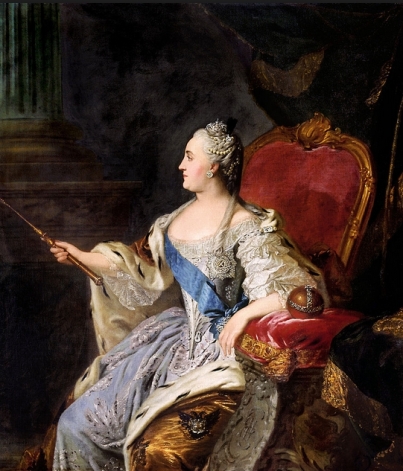
Portrait of Catherine II of Russia (1770)
Fyodor Rokotov
Hermitage Museum (St. Petersburg)
Source: Wikimedia Commons
Her ascension to the throne made a more favorable environment for arts and science. She was a very cultivated and clever woman because she had been educated reading the French encyclopedists d’Alembert and Diderot and Voltaire too. Catherine issued the Statute of national Education in 1786 and during her reign, Leonhard Euler came back to the Academy from his position in Berlin. According to E. T. Bell (Men of Mathematics. New York: Simon and Schuster, 1961):
Catherine received the mathematician as if he were royalty, setting aside a fully furnished house for Euler and his eighteen dependents, and donating one of her own cooks to run the kitchen.
Euler lived in St. Petersburg until his death in September 1783. During his second Russian period, Euler wrote nearly half of his 856 listed works and the Academy published most of them posthumously.
Catherine II was succeeded by her son Paul I and in his only five years of reign he changed the reformist policy of his mother. For example, he decreed that no Russian could attend Western-style schools, attempted to prevent foreign books from reaching Russia, and cut off all funding for academic institutions. The Academy was saved by Paul I’s son alexander I who in 1803 presided its major reorganization. It was renamed Académie Impériale des Sciences and its annual publication also changed its name for its French version Mémoires de l’Académie Impériale des Sciences de St. Pétersbourg. Those years were a new height for Russian science until the Russian Revolution of 1917. In 1925, the Soviet government moved the Academy to Moscow and now the building placed in St. Petersburg is the headquarters of the Russian Academy of Sciences.
Location: Russian Academy of Sciences (map)
Near Park Güell

Photography by Carlos Dorce
All the streets of the cities have different names and all the buildings are identified with different numbers. I was walking by the streets near Park Güell of Barcelona when I noticed this figure identifying the second door of a building: number 7,5! Have you ever seen this number over the door of a house? In Barcelona, you can see two doors in the same building and one is identified with a number and the other is identified with the same number followed by the word BIS. However, it’s the first time that I saw the fraction HALF!
Location: Map
Giovanni Vailati’s house in Crema

Vailati’s house in Crema (Italy)
Photography by Carlos Dorce
Crema is a little city near Milan. I must recognize that I wouldn’t have visited it if I had traveled to Lombardia by myself. But I was lucky once again! It’s very beautiful discovering Mathematics by chance when it wasn’t expected. I was in Crema with five of my secondary school students and two of my colleagues because of a Comenius project. We were walking through the beautiful streets of the center of the city and we found this house with a plaque which says that it is the birthplace of Giovanni Vailati (“distinguished mathematician and philosopher”):

Photography by Carlos Dorce
Giovanni Vailati was born in this house in April 24, 1863. After going to school in Monza and Lodi, he entered the University of Turin when he was 17 y.o. to study the Engineering degree. He met Giuseppe Peano (Cuneo, 27/08/1858 – Turin, 04.20.1932) there and because of him, Vaitali found his passion in Mathematics, so he attended Mathematics lessons for four years after graduating in Engineering in 1884. In the period 1892-95 he was appointed to second assistant of Peano in Turin and in 1896 he became assistant of Vito Volterra (Ancona, 03/05/1860 – Rome, 11/10/1940). During this time he taught History of Mechanics at the University and worked on the History of Mathematics and Logic, much influenced by Peano. In 1899 he decided to follow his career as a teacher in other Italian cities as Siracussa, Bari, Como and Florence.
His recognition was twofold. First, his contributions in the field of Philosophy led him to occupy a position of prestige in the organizing committee of the first International Congress of Philosophy. In addition, he studied the works of Plato, Euclid and Saccheri, among others, as well as made important contributions in the field of Logic
Location: Vailati’s house (map)
End of the Mayan Calendar

Today is the end of the World!
Sorry, it is only the end in the Mayan calendar and Google has dedicated its doodle today!
The Polytechnical Museum in Moscow
The Polytechnical Museum in Moscow is not the most popular museum in the Russian capital but it’s an interesting place if you love Science and Technology. I recognize that it can’t be compared with the Kremlin, the Red Square, the Pushkin Museum or other important sites located Moscow but you will have to go there if you have more than a few days to spent. It’s not very big and we find a lot of things related with the History of Technology and its applications in Russia and former U.S.S.R. There is a very complete exhibition about rockets, satellites and Space:
Nevertheless, it’s not a very interesting place if you only look for Mathematical objects: all the Mathematics are hidden behind the technological advances so we must satisfy with a little bit more than a ruler and a compass:
There are some posters hung from the roof of the main stairs and in one of them we find a reference to the great Archimedes (c. 287 BC – c. 212 BC) and his famous screw:
Finally, in the exhibition about the Space, we find another poster with the portraits of Bruno, Galilei, Copernicus, Kepler, Newton, Lomonosov and Einstein who are seven of the greatest names in the History of Philosophical Astronomy:
I enjoyed the Museum a lot! I hope that you will be able to enjoy it too!
Location: Polytechnical Museum (map)
The Synodal Printing House
After the Revolution of 1917, Nikolski Street was called 25th October Street. This is a very old and historical street i Moscow since in 1563 Ivan IV Vasilyevich (also known as Ivan the Terrible) founded the first printing house of Russia (the Pechatni Dvor) where in 1703 the first Russian newspaper was published. The building caught fire in 1812 and in 1814 the new Synodal printing House was built in the same place. The lion and the unicorn on the facade contrast with the communist hammer and sickle and two identical sundials:
When I saw this sundial I was walking from the Red Square to somewhere to have lunch so I was lucky for noticing this XIXth century sundial in the heart of Moscow!
Location: Synodal Printing House (map)
Khan Shatyr in Astana
This is my first post about Kazakhstan! I am very happy to be able to talk about this country which I’s like to know! Yesterday I was watching TV and I saw this fascinating mathematical structure in a report about Astana. Which form has this beautiful roof? Searching information in the official web site:
Quote from MikeSefton, Buro Happold’s project leader of the Khan Shatyr. The center’s design came from the idea of creating one vast roof which would house many venues and which would have a real feeling of space. So often in similar schemes there is a sense of individual, boxed-in buildings but by having one large tent accommodate them all. A major challenge with the project was to keep the temperature inside the space even in a climate with extreme weather conditions. We need visitors to be able to move from venue to venue inside the structure without experiencing dramatic changes in temperature.
Another challenge was the asymmetry of the design. To work to a perfect circle creates a full radial symmetry but when you’re dealing with a cone shape that is also on a lean, you only have one line of symmetry – down the central line. This means every cable anchor and cable has a different geometry as they are all at different angles. Tensile structures are all about anticlastic surfaces – surfaces that have opposing curvatures. Flat tensile designs just don’t work, so if you are considering using a tensile structure, you have to accept that it must have curves.Mountain climbers as part of the construction team. The cable net comprises of 192 radial cables and 16 circumferential cables. The installation of the foil cushions onto the cable net structure which is clad in a three-layer ETFE envelope, will take between three and four months as this can only be done during summer and autumn.To ensure the efficiency as well as to complete the installation of the cables within record time of 1 month, 650 professional mountain climbers from 7 different nations formed part of the construction team at this critical stage. They worked under severe conditions up to a height of 100m from the bottom in order to accomplish the mounting.ETFE – for a comfortable microclimate throughout the year. ETFE (ethylene-tetra fluoroethylene),a material that allows daylight to wash the interiors while sheltering them from weather extremes. The perfect material to be used in unpleasant climates.While the buildings within the envelope are fully conditioned, the target temperatures in the landscaped areas are +15 degrees Celsius in winter and +30 degrees in summer. In winter, a key challenge is to prevent the formation office on the inside of the envelope. This is achieved by a combination of temperature control and directing warm air currents up the inner fabric surface, a strategy that also prevents downdraughts. In summer, fritting on the outermost foil layer provides solar shading. Inside, low-level jets direct cool air across the space, while opening vents at the apex induce stack-effect ventilation.Project’s cable net structure is coated with 19,000sqm of ETFE foil cushions, compromising three layers assembled together, with the middle layer inflated. By inflating the cushions with air the material can accommodate a high thermal range. Each cushion is about 3.5m wide and up to 30m long.The flexibility of the ETFE material also makes it well suited to deal with the cable net’s range of movement. As the structure deflects, the cables move closer together and the cushions change shape – from an eye shape to an almost cylindrical shape.
The ETFE cushion panels are connected to the cables using a system of aluminum clamping plates. These are able to tolerate the movements of the cables under wind and snow loads.

Source: CNN
The 16 circumferential cables hold a picturesqueness structure which must be photographed if a lucky person can travel to Astana. Khan Shatyr Shopping and Entertainment Center is the new symbol of the capital of Kazakhstan. It was designed by Norman Foster and it’s the biggest tent in the World which features shopping and entertainment under the mathematical roof.
Location: Khan Shatyr (map)
The House of the Blackheads
The House of the Blackheads (Melngalvju nams) is located in the heart of the old town of Riga. It’s a building erected in the first half of the 14th century for the Brotherhood of Blackheads who was an association of local unmarried ship owners and merchants founded in the 14th century. The house is one of the most folkloric buildings in the city because of its ornamentation built during the XVIth, XVIIth and XVIIIth centuries. In the Second World War, the house was destroyed by the German bombs (1941) and the current picture was built in the period 1995-1999.

House of the Blackheads in 1891
Source: Wikimedia Commons
I’ve been in Riga twice and I’ve always admired this beautiful house! And the astronomical clock on its front!
The clock has three circles. The upper one indicates whether it is day or night and the the lower one points to the day of the week. The main clock is a calendar (days and months) and a analogical clock (hours and minutes). I want to return to Prague to enjoy its great astronomical clock but I think that this one can be just as interesting as the Czeck one!
Location: The House of the Blackheads (map)
